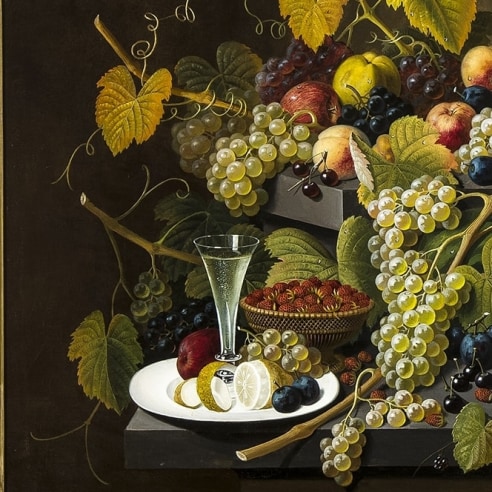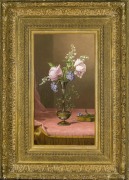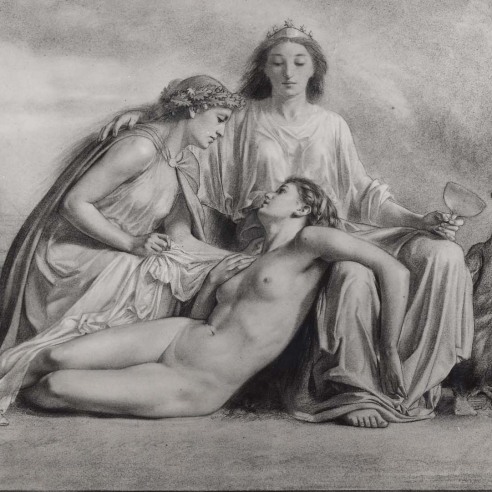
MARTIN JOHNSON HEADE (1819–1904)
Victorian Vase with Flowers of Devotion, about 1871–80
Oil on canvas, 18 x 10 in.
Signed (at lower right): M. J. Heade
RECORDED: John Wilmerding, “An American Perspective: Nineteenth-Century Art from the Collection of Jo Ann and Julian Ganz, Jr.,” The Magazine Antiques CXXI (January 1982), pp. 272, 273 illus. in color // John Wilmerding, Linda Ayres, and Earl A. Powell, An American Perspective: Nineteenth-Century Art from the Collection of Jo Ann & Julian Ganz, Jr., exhib. cat. (Washington, D.C.: National Gallery of Art, 1981), pp. [6] fig. 100 illus. in color, 99 fig. 100 illus., 139, 140 illus. // Theodore E. Stebbins, Jr., The Life and Work of Martin Johnson Heade (New Haven, Connecticut: Yale University Press, 2000), pp. 133, 306 no. 422 illus.
EXHIBITED: National Gallery of Art, Washington, D.C., October 4, 1981–January 31, 1982; Amon Carter Museum of Art, Fort Worth, Texas, March 19–May 23, 1982, and Los Angeles County Museum of Art, July 6–September 26, 1982; An American Perspective: Nineteenth-Century Art from the Collection of Jo Ann & Julian Ganz, Jr.
EX COLL.: John Peter Borter, Ellwood City, Pennsylvania; to [Hirschl & Adler Galleries, New York, 1981]; to Jo Ann and Julian Ganz, Jr., Los Angeles, California, 1981–2009; private collection, 2015 until the present
Heade painted still lifes of roses for almost four decades. He would typically portray them singly or in a small, sometimes mixed, bouquet set in a simple glass container or a metal vase resting on a piece of drapery. Heade adheres to the latter approach in Victorian Vase with Flowers of Devotion, which also reveals his penchant for tight, closely cropped designs. In this instance, Heade’s still life is composed of a pair of pink tea roses, which were interpreted in the flower literature of the day as traditional symbols of beauty and gentleness. These voluptuous blossoms are accompanied by three sprigs of lily of the valley––a flower linked with sweetness and the return of happiness. Some fragrant heliotrope and trailing jasmine foliage complete the ensemble, which has been set in a Classical Revival vase with a trumpet-shaped neck emerging from a round, covered bowl, their curvilinear forms enriching the decorative quality of Heade’s arrangement.
As the title of the painting implies, the floral specimens Heade selected for his composition evoke feelings of affection and commitment to a loved one. This would suggest that the book lying next to the vase may be a volume of romantic poetry, while the flower that was intentionally placed on its cover was meant to serve as an allusion to the passage of time or a cherished memory. The subtle illumination is typical of many of Heade’s still lifes, as is the unadorned background, but Victorian Vase with Flowers of Devotion is unique in that it is one of only a few rose subjects which show a vertical line, indicative of a corner of a room.
Heade defines each element of the composition with precise brushwork, accurately portraying the diverse array of shapes and textures, especially the soft petals of the tea roses, which have a tendency, as one commentator has observed, to “nod as if the blooms were too big for their stems." He combines his firm handling with a palette dominated by soft pinks, reds, and tans which are balanced and offset by cool greens, purples, grey, and touches of white. The end result is a work of art that stands out for its elegance, sentiment, and quiet restraint––qualities that no doubt appealed to the affluent business types, such as Cyrus W. Field of New York and William B. Bement of Philadelphia, who acquired Heade’s floral pictures for their parlors and boudoirs.





